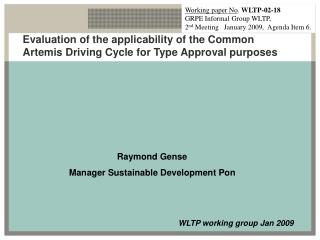Artemis Driving Cycle

• • • A driving cycle is a series of data points representing the speed of a versus time. Driving cycles are produced by different and organizations to assess the performance of vehicles in various ways, as for example consumption and emissions.
And tests are performed on. Tailpipe emissions are collected and measured to indicate the performance of the vehicle.
Another use for driving cycles is in vehicle simulations. More specifically, they are used in propulsion system simulations to predict performance of internal combustion engines, transmissions, electric drive systems, batteries, fuel cell systems, and similar components. Some driving cycles are derived, as it is preferred in the, whereas others are direct of a driving pattern deemed representative. There are two types of driving cycles: • Transient driving cycles involve many changes, representing the constant speed changes typical of on-road driving. • Modal driving cycles involve protracted periods at constant speeds.
Can produce several different standard driving cycles used for automotive emissions, range and energy consumption testing. Using this block might save time and effort - I am sharing it to speed up student simulation classes and projects. At present, the block represents the following cycles: NEDC, Artemis, WLTP Class 3,.
The American, and the unofficial European driving cycles are transient, whereas the and cycles are modal cycles. Some highly stylized modal driving cycles such as official European are designed to fit a particular requirement and bear little relation to real world driving patterns. On the contrary, the forthcoming is striving to mimic real word driving behavior. The most common driving cycles are probably the,, and the, the later corresponding to urban driving conditions solely. Driving cycle design is the core technology for these standard cycles.
In Greek mythology Leto was one of the female Titans, a bride of Zeus, and the mother of the twin gods Apollo and Artemis. She was the goddess of motherhood and, with. Apr 21, 2009. • Real-world emission test procedures. – Driving and test cycles, for PC, HGV, measurement method, uncertainty analysis, recommendation. • Measurements and modelling of the emissions. – 130 cars tested, database incl. 3,000 light vehicles. – 120 engine maps (lorries, busses) + transient. See figure: 'Common Artemis Driving Cycles (CADC) [9] ' from publication 'Electrification of transport logistic vehicles: A techno-economic assessment of battery and fuel cell electric transporter' on ResearchGate, the professional network for scientists.
[ ] Optimization and are employed to design a driving cycle. [ ] is applying to Hybrid Electric Vehicle. Contents • • • • • • Data Collection [ ] Data collection from the test road is the most important activity. Test road (e.g. City, highway, etc.) measured data are the inputs to the 'Drive Cycle' preparation activity. The procedure involves instrumentation of the test vehicle to collect information while driving on the test road.
There are two major types of data to be collected, Driver Behavior data and Vehicle versus Road data. Envision G22lwk Driver Windows 7. The Vehicle versus Road data are used to prepare the road drive cycle and the Driver Behavior data to prepare the Driver model. For example, to calculate a vehicle's fuel consumption either in computer simulation or in chassis dynamo-meter which is going to be launched in India, it must run on an Indian road with an Indian Driver. Indian Drive Cycle with a European driver model does not give a fair comparison of the on road trials. Driving Cycle Design [ ] The 'Drive-cycle' basically is the representative of the road. Drive cycles are used to reduce the expense of on road tests, time of test and fatigue of the test engineer.
The whole idea is to bring the road to the test lab (a chassis dynamo-meter) or to the computer simulation. Two kinds of drive cycle can be made. One is DISTANCE DEPENDENT (SPEED versus DISTANCE versus ALTITUDE) and the other one is TIME DEPENDENT (SPEED VS TIME VS GEAR SHIFT).
The DISTANCE DEPENDENT is the actual replica of the test road whereas TIME DEPENDENT is the compressed version of the actual time taken to conduct the test on road. Examples of TIME DEPENDENT drive cycles are European NEDC cycle, FTP-75.
TIME DEPENDENT drive cycles are used specifically for chassis dynamo meter testing because in a short time the results can be availed and repeated tests can be done easily. Driving Cycle Recognition [ ] Based on the type of application drive cycles are made. Drive cycle for passenger cars are different from commercial vehicle. Driving Cycle Prediction [ ] This is a technique for prediction of future driving cycles and patterns for different types of vehicle applications. These cycles are used as an important input in designing and evaluating future power train systems and vehicle concepts. As of today, obsolete drive cycles are used during the design phase and due to this the changes in traffic conditions and infrastructure which has occurred during the last decade are not taken into account. Therefore, the need for new drive cycles representing today or the next few decades is great.